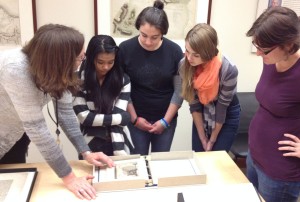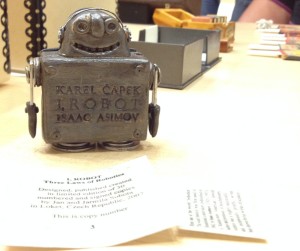“Look at how a single candle can both defy and define the darkness.”
― Anne Frank

Molly Swartzburg, curator of The Albert and Shirley Small Special Collections Library of the University of Virginia, hosted a group of students from the Teen Writing Center last Thursday. She had a little help from Thomas, of course, as he stopped to greet the first-comers.
There are no stacks to browse through at this library, materials are only available on request through Virgo, the UVA online catalog. Molly keeps her own blog with intriguing topics designed to showcase parts of the collection that are interesting, relevant to the day, and which might go unnoticed. Her blog cannot match her passion for her job and this collection, and it was obvious in her care and selection of the books she chose for our visit. Not knowing what the library held, our students had requested to see some poetry, some older books, and left the rest to Molly, and Molly pulled out all the stops.
 Molly selected a progression of books beginning with a 14th Century French Book of Hours, the illuminated story of Saint Margaret and the Dragon. What made this particular selection so perfect was the example it provided students who just finished using a letterpress printer, of the kind of book available before the arrival of the Gutenberg Press. Molly’s entrancing descriptions of the place in class the possession of a book like this indicated, along with the story behind St. Margaret, were as interesting as her detailed comparison of the hand lettering to the Gutenberg press Blackletter typeface.
Molly selected a progression of books beginning with a 14th Century French Book of Hours, the illuminated story of Saint Margaret and the Dragon. What made this particular selection so perfect was the example it provided students who just finished using a letterpress printer, of the kind of book available before the arrival of the Gutenberg Press. Molly’s entrancing descriptions of the place in class the possession of a book like this indicated, along with the story behind St. Margaret, were as interesting as her detailed comparison of the hand lettering to the Gutenberg press Blackletter typeface.
Students were delighted to find that they could understand the French text with Molly’s help, and noted the similarity of the Blackletter typeface used by Gutenberg to the handwriting in the Book of Hours. It was an “aha” moment to realize that Gutenberg created a typeface that resembled the only known writing at the time, handwriting, for students who have had the modern array of fonts at their fingertips for as long as they can remember. The recent experience of printing brought into focus how few people had books before the Gutenberg press, and how much the press revolutionized information. Molly pointed out that we have a similar revolution they are living in the middle of, and this group of young writers seemed convinced that the codex of the book would survive in tandem with digital access.


Favorites included a leap to the modern in the miniature art book, I, Robot, part of the thousands of miniature books housed in the collection. The ability to handle the books allowed a more intimate connection to the evening. What interests a curator of such a rich collection? The reading passions of the students. One of her first questions was which of the books in the room held the most fascination for each?

The high point of the event was an introduction to Walt Whitman with a signed, first edition of his chapbook, Leaves of Grass, a discussion of his impact on poetry, and a first page reading by Molly. Very few students can say they have held a pivotal moment of literary history in their hands. Molly brought it unforgettably to life.

To lighten the meeting, we turned again to illuminations, and finished with a very recent acquisition from a local artist from Richmond. This chapbook is printed in ultraviolet ink, by Justin James Reed, and has to be viewed with a flashlight! Without the flashlight, it resembles a blank signature without mark on cover or page. We are told it is a challenge to curate, for in the light, there is little to indicate it is more than a sheaf of blank, unbound pages. Who would know it was a book, and not paper left by a student?
To close the meeting, Molly asked each student which two books they would rescue if the library was burning. I think every book found a willing pair of hands, and we all enjoyed the insightful look at our preferences. When we next looked up, our time had passed, and not one student was ready to leave, and one adult was heard to comment that she would be hurrying back. To add to what was already a spectacular experience, Molly invited students of the Tupelo Press Teen Writing Center to donate a copy of their winter chapbook of student work to the library’s collection. By 2014, our student’s names will be listed as authors alongside the treasures they just enjoyed. Our great thanks to Molly, and to the University of Virginia for insuring that this amazing collection is curated by such a treasure.

